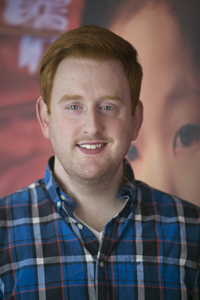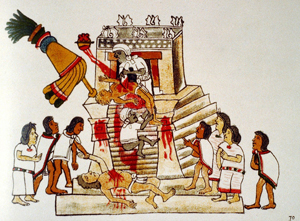Researcher of the Month
June 2015
Ryan Hunter
History major
Research Mentor: Dr. Elizabeth Newman, Department of History

When the Tufts Historical Review let it be known that they were out for blood, Ryan Hunter, History major, answered the call.
“This year’s theme is blood. Blood is a symbol ubiquitous in the study of history – family, mortality, warfare, medicine – blood binds them together like a thread through the course of human development. As a symbol of war, blood and iron bound Germany; and as a symbol of family, blood crowned King Henry VIII. In a more literal sense, Prince Alexei’s disease of the blood brought Rasputin to court, and Hippocrates’ theory of humors defined medical practice for centuries. And these, of course, are just a few examples. The Tufts Historical Review Editorial Board seeks outstanding articles that explore our theme from a diverse array of perspectives.”-Tufts Historical Review Call for Submissions
After being encouraged to send his paper in by his mentor, Dr. Elizabeth Newman (History), Ryan was delighted to learn this past April that his essay was accepted for publication. Titled “Aztec Human Sacrifice: Solemn Blood Covenants and Sacred Atonement Offerings”, Ryan’s paper explores the intersection between Aztec theology, political ceremony and legitimacy, and the phenomenon of mass-scale blood sacrifice. “For the Aztecs,” Ryan explains, “human sacrifice and bloodletting were not understood as barbaric, senseless rites of slaughter but as the most intimate ways humans could participate in the divine.” Ryan Hunter was also one of a dozen undergraduates who delivered a talk at the Department of History’s symposium which was part of the URECA campus wide Celebration event on April 29.
 A local resident and graduate of Ward Melville HS, Ryan transferred to Stony Brook
in fall of 2014 from American University, where he had previously done some scholarly
work with Dr. Douglas Klusmeyer on The Thirty Years War, and with Dr. Laura Beers
on Ellen Wilkinson MP; and also studied abroad at the University of Edinburgh in spring
2012. Ryan regularly contributes articles for the Institute on Religion & Democracy,
and has been active in interfaith student groups. He has also been published in the
local Village Times Herald, and is engaged in a long term project he hopes to publish— writing a trilogy that
brings to life an imagined series of dynasties and civilizations based on an alternative
history in which the Roman Empire never ended. At SB, Ryan works part time in the
Offices of Conferences and Special Events.
A local resident and graduate of Ward Melville HS, Ryan transferred to Stony Brook
in fall of 2014 from American University, where he had previously done some scholarly
work with Dr. Douglas Klusmeyer on The Thirty Years War, and with Dr. Laura Beers
on Ellen Wilkinson MP; and also studied abroad at the University of Edinburgh in spring
2012. Ryan regularly contributes articles for the Institute on Religion & Democracy,
and has been active in interfaith student groups. He has also been published in the
local Village Times Herald, and is engaged in a long term project he hopes to publish— writing a trilogy that
brings to life an imagined series of dynasties and civilizations based on an alternative
history in which the Roman Empire never ended. At SB, Ryan works part time in the
Offices of Conferences and Special Events.
Ryan is passionate about history (particularly the Empire periods of Russia, China, Rome, and Britain), emphatic about the value of doing research and finding a mentor, and postulates: “Even though our university is so known for the sciences, I hope that we will become known more for the humanities.” Indeed, Ryan has relished the classes he’s taken at Stony Brook--including the Aztec civilization course he took with Dr. Newman, and advises fellow humanities students here at SB to be assured “You’re in the right school, don’t worry!” Ryan will be graduating in December 2015; and plans to pursue a Ph.D. in history. Below are excerpts from his interview with Karen Kernan, URECA Director.
The Interview:
Karen. What is your research about? What work did you present at the History Symposium/URECA
Celebration?
Ryan. This past fall I was taking a course on Aztec civilization with Prof Elizabeth Newman.
I was always very interested in the Aztecs. I first learned about them in 5th grade,
I believe, in elementary school. …This very strange phenomenon that the Aztecs were
known and despised for—mass scale human sacrifice—was something I wanted to better
understand. I became really interested in the theology, the intellectual and religious
beliefs behind human sacrifice. And so for this course I took in the fall, I asked
my professor if I could write an extracurricular paper on the theology behind Aztec
human sacrifice. She said yes; and ended up liking what I wrote and emailed me a link
to the Tufts Historical Review. The theme for Tufts that year was “blood.” . . . Well, I thought, "I’ve got a relevant
topic here with human sacrifice." So I submitted the paper I’d written, along with another
paper I’d spent a lot of time on as well, on the limits to early modern Jewish personal
agency. I thought if either would be considered, I thought it would be most likely
to be that one. So it was a funny surprise when I got the email in April telling me
that the Aztec one was accepted. That was unexpected.
What were some of the challenges you faced in doing the research for your Aztec paper?
A real problem of Aztec historical studies is that they did not have a written language
that we’re able to decipher. The Aztecs used pictoral glyphs to communicate and transcribe
great state occasions (funerals of emperors, coronations, etc). So all the written
accounts we have of the Aztecs come from the Spaniards. As a historian, it’s a bit
like trusting an Ottoman Turkish account of what it was like to live in Byzantine
Constantinople — trusting the victor to write a dispassionate account about the people
he’s conquered. The most helpful source for me was looking at the Codex Magliabechiano.
The codex stands out because it was a deliberate documentation of human sacrifice
at a time when a lot of the Spanish priests who were operating in Central America
were trying to eradicate it from human history.
Was there anything particularly surprising that came out of the research/writing the
paper?
I remember in 5th grade …when we started learning about the Aztecs…I couldn’t take
my eyes away from the gruesome depictions. But I realized: Why am I haunted by something
I don’t truly understand? Let me try to understand it as best I can. And as I spent
more time looking at the Aztec sacrificial hymns, I came to appreciate an actual beauty
in the language of the hymns even as they are describing these barbaric rites. The
beauty captivated me, I have to admit. …If you look at polytheistic Roman hymns, or
ancient Chinese or Indian hymns, you realize that there’s a profound beauty which
transcends creed.
I think perhaps what made me most uncomfortable was reconciling belief systems, and coming to terms with the fact that there are more similarities in the beliefs between Christianity and Aztec than perhaps one would wish there were…
Did you enjoy giving a talk at the symposium?
Yes, I really like public speaking. I took a class on public speaking in 10th grade, which I loved, and so it was a great joy to be able to share my research at
URECA. But especially, it was a joy to sit and observe the other presenters. The research
was at an incredible caliber. There were subjects ranging from the efficacy of Nazi
uniforms in dehumanizing the Nazi commanders and their victims, to the NYC Tenement
museums and how the preservation efforts were so fraught with difficulty. There was
one talk on the authenticity of medieval conversion narratives from Judaism to Christianity,
one of my favorite areas of research. It was a joy just to learn from all of the different
presenters.
Did you get some good questions at the symposium?
A wonderful question that was posed to me, was: “well, how do we know that they believed
this?” To which, I responded, “We don’t know, there’s no definitive answer. As historians,
all we can do is try to piece together the likeliest outcome.”
What are your long term plans?
I want to pursue a PhD in History and I want to teach. My favorite areas are the
empire periods of Russia and of Britain. Those would be my favorite areas to teach.
I am also interested in teaching any aspects of ancient, medieval or early modern European
history, Chinese history, Japanese history…
What do you want others to know about doing humanities at SB?
Like many SB students, I’m a transfer. And from my own experience – I am and have
been immensely impressed by faculty here -- by their breadth of knowledge, and their
approach to teaching. At SB the value of good teaching is really emphasized so much.
So even though our university is so known for the sciences, I hope that we will become
known more for the humanities.
What role did your mentor play?
Professor Newman is a wonderful mentor and a truly extraordinary teacher – full of
humor and with such a passion for the subject. She has been so encouraging to me.
I have been fortunate to have good mentors here at Stony Brook, and at my previous
college as well. ………Doing research, finding a mentor, really does open so many doors.
It’s crucial to your professional development and intellectual sense of well-being.
I wish for everyone that it could be a part of their college experience. Even when
I was going through difficult times, to have their encouragement has been a great
blessing.
Any advice for students?
What to me has been the most helpful thing is to find mentors that truly do encourage
you to research and that validate and share your academic interests. We have so many
faculty here with such diverse interests. Prof. Newman even introduced me to a professor
whose main area of expertise was on the Hittites, an ancient Middle Eastern peoples
who vied for regional power with the Egyptians – I hadn’t realized this could be one’s
specialty…So what I’m trying to say is: there are so many faculty with so many interests…
just find a faculty member you like. Find a mentor.
